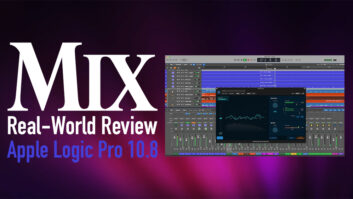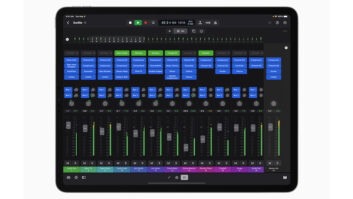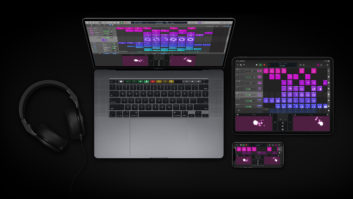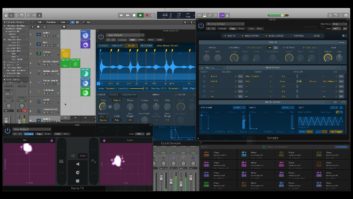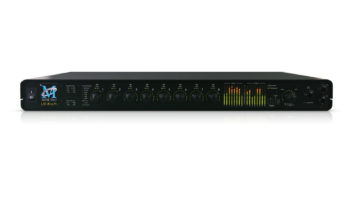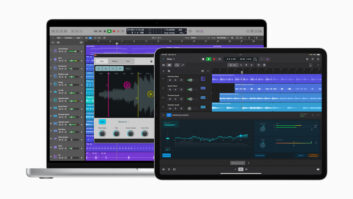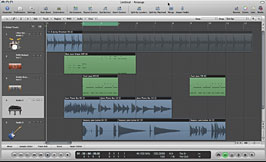

Apple acquired the Logic DAW when it purchased Emagic in July 2002, but until now the application looked much the same as it always did. Even after Apple’s major upgrade to Logic Version 7 in 2004, the app’s main downfall remained that it put flexibility before ease of use. Its feature set was great, but the GUI could become a nightmare of floating windows, obscure terminology and hidden key commands.
Logic Pro 8 remedies this problem by retaining the DAW’s flexibility while making ease of use a priority, as well as adding expected functions and a few unexpected touches. Many users hoped that Logic Pro 8 would adopt a more Apple-esque look and feel, and with this new, extensive upgrade, it does. But what is most surprising is the price ($499) and the package’s many features. The Logic bundle incorporates more than one app, but for this review I’ll focus on Logic Pro 8 alone.
Logic Pro 8’s Arrange window showing tracks and regions
WHAT DO I GET?
When I first heard about Logic Studio’s updates, I expected to encounter the phrase “limited-time offer.” Luckily, those words were nowhere to be found. Logic Studio includes Logic Pro 8; Soundtrack Pro 2 (reviewed in the December 2007 issue), Apple’s audio editing/sound design app from Final Cut Studio; and MainStage, a new program for hosting software instruments and effects for live performance. Also included are five Jam Packs providing more than 18,000 Apple Loops and a wide range of new sampler instruments. Apple Loops are either Real Instrument Loops or Software Instrument Loops that conform to the session’s tempo, making it easy to get a track started as a demo or for more serious musical endeavors. (If you thought that Apple Loops are for kids, visit mixonline.com/online_extras/umbrella-mp3-logic8, where we offer a clip of Rihanna’s “Umbrella” from her 2007 Def Jam release, Good Girl Gone Bad, next to Vintage Funk Kit 03, the Apple Loop that acted as the basic building block for the song.)
Next in the list of features comes 1,300 total instruments; Xtreme Analog and Xtreme Digital EXS instrument libraries; 15 True Surround effects and two True Surround instruments; 1,000 multichannel sound effects and music beds taken from Final Cut Studio 2; and 2,400 channel strip settings — chains comprising Studio Instruments and multiple Studio Effects. This entire suite of goodies is hosted by Logic Pro 8 itself, which has been reworked into a user-friendly, single-screen interface that not only redefines Logic’s workflow, but also pays homage to the past by allowing users to work as they always have.
Logic also includes an Artist Spotlight DVD featuring tracks from Shiny Toy Guns, The Roots, Plaid and other artists. By clicking on the group’s name, you will get a commercially released track broken down into its components so you can see how the artist recorded the tracks and how the mixer came to the final outcome. There are both stereo and 5.1 mixes on the disc and some have included videos. This is a great way to see how Logic ticks from the eyes of the artist and engineer. There are Logic plug-ins, Apple Loops and instruments on many of the channels so you can see how the engineers and artists crafted the sound, and how the plugs and instruments are set up in a variety of situations.
LET’S GET IT STARTED
Logic Studio came loaded on an Apple Mac Pro 2x 3GHz dual quad-core computer with 8 GB of RAM. After launching the app, I selected Create New Project, and right off the bat I saw something new: The screen was segmented into two boxes. This is unlike past versions of Logic in which a Setup Assistant asked questions about audio interfaces, sample rate and more. There are now collections on the left titled Explore, Compose and Produce. Within each of these collections is a list of templates in the right column. If you choose Compose and Orchestral, for instance, Logic Pro 8 loads the appropriate Jam Pack sounds to your category and gives you a track and empty track regions in which to work. From there, it was easy to create a new track with a handy “+” button — a common Apple feature found in iCal or Address Book that is used to create new entries or categories. If you’d rather not take advantage of this framework, then you can open an empty project. In this case, Logic asks you what kind of track you want to create. You have the options of audio, software instrument or external MIDI, and you can go on from there as you wish.
What’s most apparent in the new session is that Logic looks like it’s built from one screen. This is the Arrange window — nothing new to Logic users, but now it includes retractable panes that provide access to all the primary editors and browsers that previously were only available in separate windows. This main screen is all you’ll need to take a production from beginning to end. Yes, this is much like the GarageBand model, but don’t think for a minute that this is “GarageBand Plus” because Logic has some serious horsepower and options unlike anything you’ll find in other DAWs. Keep in mind, though, if you want to work with separate windows, you may do so by opening them up and dragging them to a second monitor, or have them behind the Arrange window.
CUSTOM CHOICES
Apple’s hand in Logic’s software design is most apparent in the toolbars across the top of the Arrange window, which are consistent with iWork, Soundtrack Pro 2 and Final Cut in a number of ways. First, you can customize your toolbar with a Control-click (or right-click if your mouse has that option). When you choose Customize Toolbar, a screen with 40 choices will pop up and let you drag your favorites up to the toolbar. This is unlike past versions, in which certain key commands were permanently relegated to the land of the obscure pull-down menu or operator’s memory. Now you can make the toolbar your own.
At the bottom of the Arrange window is a customizable transport. A Control-click or right-click brings up a master window full of checkboxes that allow you to add options such as Play From Selection. Simply click on the check box and the button appears on the transport. Just above the transport are tabs for bringing up the editors. In previous versions, viewing the mixer required switching to a mix screen; now, you click on the Mixer tab. The Sample Editor, Piano Roll, Score and Hyper Editor, previously available only as separate windows, can now be opened within the Arrange window using tabs that run along the bottom.
Key command sets can be customized, saved and recalled on the fly so that you can jump between sets. This is great for a multi-user project, where each user could have his/her own sets of key commands that could be shared locally, through a newtorked computer or through a .Mac account using new sharing features, which can also be used to share plug-in and channel strip settings.
There is a slick track-zooming feature, Auto Zoom, which will automatically size your track as you click or arrow up and down the list. First, manually zoom any track by going to the lower left hand side of the track name window where a hand tool will appear. Click on the corner and adjust the window to any size you like. If you click onto another track with Auto Zoom off, the window you just sized will remain the same size. However, with Auto Zoom on, if you use the up/down arrow key or click on another track, the tracks you move to will pop to the expanded size, while the track you just left collapses back to its original size. This is very handy for automatically sizing a track as you arrow around your mix.
IT’S ALL ABOUT CONTEXT
To view and manage your compatible Logic media in a variety of ways, the right side of the Arrange window has tabs that provide access to a set of Media browsers. The Bin tab displays your current project’s audio files and regions. You can use the File Browser to search your hard drive, find Logic-compatible media and load it into your session. For instance, you can search for files with a certain file name that have a bit depth of 16 bits, all without leaving the app, and a Loops tab allows you to search for and import Apple Loops into Logic.
The Library tab lets you browse software instrument and effect settings, channel-strip settings, external MIDI routing destinations and more. The Library can change context depending on what you’ve selected elsewhere. For example, select a software instrument track and a set of instrument channel strip settings are displayed. Highlight a plug-in inserted on the channel strip and the settings for that plug-in are displayed. You can also filter the display based on search criteria, and as with other familiar Apple apps, these are searchable via the mouse or arrow keys.
Also worth mentioning is how Logic organizes these settings. If you click on an individual channel plug-in, such as Space Designer, the Library shows Space Designer settings including Large, Small and Medium spaces with their corresponding subcategories. All the settings go from short to long decays, top to bottom. There’s no need to search for this data on the plug-in itself, which would clutter the session above your mixer or Arrange window.
MIXING IT UP
The Mixer and Inspector work hand-in-hand to give the user some incredible features that speed workflow. Most importantly, signal flow viewing choices abound. For instance, the Dual Channel Strips found at the base of the Inspector provide access to the selected track’s channel strip and any Output or Auxiliary channel to which it is sending signal. The “Single” view option found in the Mixer window itself lets you see only the channel strip of the selected track, plus all Output and Auxiliary channel strips to which it is routing signal. It’s like Pro Tools’ Show/Hide groups function, but it’s automatic. This lets you easily troubleshoot your signal flow on individual channels, because all you see is other channels sharing a signal path.
Making a send and accompanying aux return is also greatly expedited. For example, when you choose one of your 64 stereo buses from the Sends pull-down menu on the channel, rather than having to create a “home” for your processor, Logic automatically creates the aux input and puts it in the mixer window.
CREATING A TRACK
I created a demo in a short time with just a guitar. I began by bringing up an Apple drum loop simply by dragging and dropping from the Library onto the Arrange window, which automatically created the track. I got the tempo where I wanted it and the loop followed along with no glitching or ugliness. Next, I created a track for my guitar from the lists in the Library under Guitar, Clean and Dual Chorus. The guitar track automatically brought up an easy-to-use tuner, allowing me to quickly tune the instrument. After clicking on Record, a window popped up asking where I wanted to put the audio files and I was off to the races.
QUICK COMPS
I used the slick multitake recording function by making a selection and engaging Record. Each time I played the section, a new pass (called a sub-lane) was created as it repeated. You can do this as many times as you like and it’s automatic. You can then audition parts of each take region by using Quick Swipe Comping. This new feature lets you choose the audio from each sub-lane and hear the results immediately. You can save as many comps as you like and recall them from a list. Once you decide on the final, you can simply choose the folder or choose Flatten Comp, and all the regions from the original tracks are laid end-to-end in the main channel. The advantage of flattening is that you can then move the audio regions individaully or change the crossfades.
IT’S OUT OF HERE!
Apple has knocked it clean out of the park with Logic Studio and Logic Pro 8. It’s worth stating that Logic’s resources sound excellent. The included processors, instruments, loops and samples are all top-notch. Space Designer and Delay Designer are true 5.1 time-based effects, and the impulse responses for the reverb are rich and deep with lush tails. The ES2 instrument’s sounds are mind-blowing — a sound designer’s dream. Going through the settings, especially in surround, is impressive.
This is the first time I’ve seen a DAW take full advantage of what a computer does best. The well-written software presents pertinent data clearly and automatically. The streamlined GUI redefines workflow and gives the competition something to envy. In addition, the long-sought-after introduction of multimono plug-ins; no-charge extras such as MainStage and Soundtrack Pro 2, Apple Loops and Jam Packs; and pricing at $499 is nothing short of jaw-dropping.
But, of course, this isn’t a perfect world, and there are a few items on my wish list for V. 8.1. For starters, there is still no true stereo panning. You have the opportunity to change the pan rules when you pan hard-left/right (0dB, -3dB or -3dB compensated, where center is zero but 3 dB is added when you pan hard-left or -right), but there is still no easy way to have dedicated panners on a stereo track. Speaking of panning, I found it a minus that there is no panner available on your aux send. This would not allow you to create headphone cues when the artist might want to hear a different panning scenario than what you’re hearing, nor specialized panning for mix effects returns. The workaround is the Post-Pan button, which allows you to reflect the panning of the channel, but is clearly not as flexible as having separate panning.
All that said, Logic Studio is a no-brainer purchase, but if you still don’t want to spend $499, you can get Logic Express for $199. Unlike past versions, Express only takes you down a few notches from the Studio package, leaving out TDM support, surround support, Distributed Audio Processing and support for high-end control surfaces. If you were waiting to make the jump to Logic or have longed for a great second resource in the studio that won’t break the bank, now’s the time to get this one. Logic Pro 8 is what it needs to be: an affordable, professional one-stop production app for engineers, composers, sound designers and live musicians.
Apple, 800/692-7753, www.apple.com.
Mix technical editor Kevin Becka was recently elected to serve on the SPARS Board of Directors. He thanks Robert Brock for his help in this review.

The Surround Panner lets users grab the front three channels and move them as a group.
Surround Features
Logic’s surround capabilities have increased considerably in Logic Pro 8. For example, you can now record a surround track and see I/O levels on multichannel meters. The panning is top-notch, with a great-looking interface that lets you easily move up to 7.1 individual channels or groups of channels. Surround signal flow is supported throughout the DAW — even in busing for porting your channels to surround processors. Speaking of which, the included Delay Designer and Space Designer plug-ins are now true 5.1 processors, with the reverb offering a great-sounding group of new impulse responses from the best rooms in the world. You can also use your other plug-ins in multimono mode, providing a variety of options from existing resources. Using the included Compressor app, you can encode your mixes in Dolby AC-3 format for playback on any standard DVD player with Dolby Digital surround playback. And if you jump from surround to stereo on the same session, you can use the Downmixer plug-in to make your job easier. These surround features take Logic light-years beyond where it’s been, providing all the necessary tools for taking a project from concept to consumer.
— Kevin Becka

LISTEN:
MP3 of a vintage funk kit recorded through Apple’s latest upgrade
